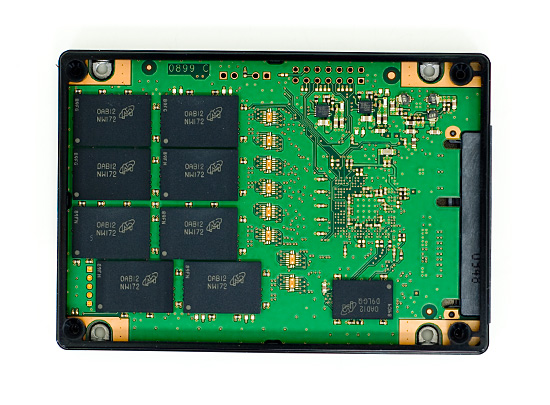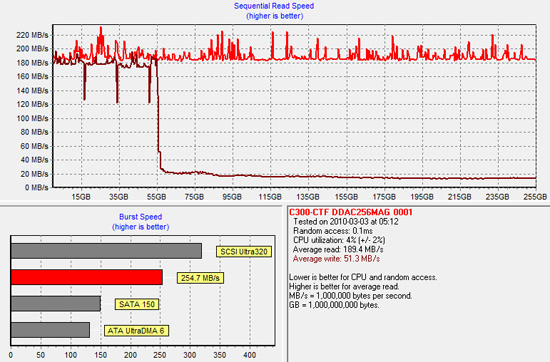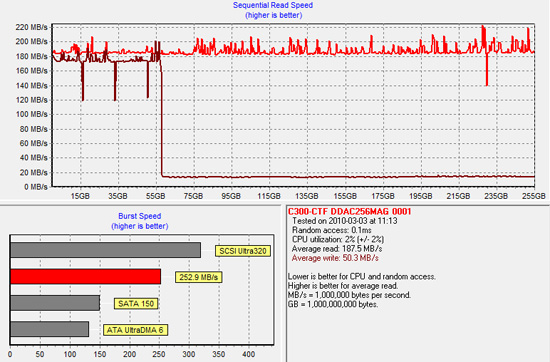Crucial's RealSSD C300: An Update on My Drive
by Anand Lal Shimpi on March 25, 2010 1:28 PM EST- Posted in
- Storage
Earlier this morning I published an article looking into the performance of 6Gbps SATA controllers, both integrated and off-chip. In it I mentioned my recently deceased Crucial RealSSD C300 that decided to up and stop working one day. Given that Crucial is selling these drives, I wasn't too happy with the outcome.

Inside Crucial's RealSSD C300
The drive would not longer be detected on POST. In fact, with the C300 connected to any machine I couldn't get any OS to boot; the system would just hang at drive detection. After a couple of weeks of toying with my dead drive, Crucial came back to me with an explanation of what's going on.
"We determined that the drive wasn’t bricked, but that it was very slow at powering up due to errors in the firmware tables that resulted in the characteristics you were seeing. We’re still investigating these errors."
I still don't know why the firmware tables developed errors, but presumably if your drive has found its way into this state then your data should still be intact. Now the second problem.
When I got my replacement drive I wanted to see how well the C300's TRIM function was implemented. I'd recently run into a couple of SSDs that don't appear to recover well after used LBAs are TRIMed. Unfortunately, the C300 joined the list. Here's a look at a sequential write across the entire 256GB C300 after I've peppered it with random writes:

Write performance does not look good. While parts of the drive can still write at around 180MB/s, the last 60GB of the drive are limited to about 20MB/s. A quick format across the drive should invoke the TRIM instruction for all LBAs and tell the C300 that it none of the data on the drive is needed and those blocks can be recycled immediately. Performance should restore to new (constant ~200MB/s across all LBAs). Unfortunately, it doesn't:

In fact, performance got worse. Let's TRIM the drive once more for good measure:

Ouch. The drive won't come back, period. The only way to restore it to full performance is to perform a secure erase. Now this scenario is a corner case and it's not one I'd expect any desktop user to run into in a short period of time. However, it is possible that after several months or years your drive might find itself in a situation where its performance never recovers. Crucial's response to the issue is below:
"...we have been able to replicate the circumstances where performance after a format does not return to acceptable levels, and we have developed a solution. We plan to integrate this into our production line and we’ll make it available to current customers. We’ll send you the code after it’s been thoroughly tested.
As we’ve mentioned before, we perform thousands of hours of testing before going into production. And as you’ve shared in one of your articles, testing every single combination of hardware, software and usage is highly improbable. We really appreciate all the feedback you have provided, as it allows us to make sure that our ongoing product improvements and updates are as comprehensive as possible."
Despite Crucial's promises of doing a ton of validation, things like this do get through. It's not a problem specific to Crucial, remember that Intel had a similar situation crop up in its early X25-M days. This isn't the first SSD to fail on me either. It's because of problems like these that I recommend waiting before jumping on any new, unproven SSD. Just a heads up in case you're thinking about making the jump anytime soon. If you are interested in how the C300 performs, take a look at its results in our new SSD Bench database.










49 Comments
View All Comments
Anand Lal Shimpi - Thursday, March 25, 2010 - link
TRIM support isn't the problem, the issue is that the drive's internal firmware doesn't appear to be cleaning the dirty blocks properly when they are no longer needed. It's most likely stuck in a loop of cleaning/recycling the wrong blocks (hence the high performance for the first ~55GB of the drive) and not touching the rest of the drive.Take care,
Anand
kmmatney - Thursday, March 25, 2010 - link
In real life, maybe having the first 55GB of the drive cleared with TRIM will be enough, as long as the rest gets a TRIM when needed.TheLastOracle - Wednesday, March 31, 2010 - link
Anand,After I red your first review of C300, I bought one (256GB) from on-line store. The C300 was shipped one day before you disclosed the drive has firmware issue. I just got this drive today and not open the box yet.
Shall I return the C300 or wait until the Crucial release the firmware fix? If I return the drive, which 256GB SSD do you recomand?
leexgx - Wednesday, March 31, 2010 - link
M225 256GB {that i now own} or vertex as both are Parters with the parts that are inside the SSD so they tend to get the Firmware updates firstMr Perfect - Thursday, March 25, 2010 - link
Wow. I had no idea TRIM wouldn't work on some drives. There are others that do this too?Hopefully their fix works as advertised, because as it stands now, that's a no sale right there.
LoneWolf15 - Friday, March 26, 2010 - link
All of this just makes me wish someone could make a reasonably-priced PCIe x4 or x8 caching SATA RAID controller with battery backup. I don't need the performance of an SSD, but I'd love to get a little more performance out of the basic RAID-5 on my desktop without having to pay $200-300 for a controller, and then ANOTHER $200 for a battery kit that probably has a 150-200% profit margin.If I could get a hardware-RAID controller with a modest cache (or a socket for an add-your-own-SODIMM-setup) AND battery for $150-200, I'd consider it. Meanwhile, I'll settle for ICH10R --at least going from the Matrix Storage to Rapid Storage Technology drivers seems to have bumped up performance a little.
529th - Tuesday, March 30, 2010 - link
I am soooo itching to buy one of these 256g models.If I bought one now while NE has lowered the price, would I have to to a full OS re-install after the firmware comes out? And where can the firmware be downloaded at? I've checked their forums and they seem to be a little dis-organized.
Any last things I should be concerned about before buying this drive?
vniwaja - Tuesday, March 30, 2010 - link
The NE price doesn't look that low at $680 unless you are able to get some sort of additional discount. I ordered one last weekend from TigerDirect for $700. With weekend BCB at 15%, the final price was $595. Currently, BCB for NE is 2%. Might want to wait for another 15% deal as they do return periodically.leexgx - Wednesday, March 31, 2010 - link
and where is the spam buttonMike11317 - Saturday, April 3, 2010 - link
I just bought a 128 MB C300, and I am NOT happy with it. Maybe what's going on is related to the need for a firmware update? A completely clean install on Win7 where Win7 created the partitions (I needed two). The starting offset in msinfo32 shows the partitions are aligned, an integer when divided by 4096. I've done all the tweaks to prefetch, superfetch, defrag, swapfile, and then tried them back on again (except defrag). This is in a Dell Mini 10, which I travel a lot with. The C300 works very fast for about 1 minute, then stalls for about 15-20 seconds, then repeats, fast for about a minute, then stalling. The stall is so bad that the window title bar says "Not Responding." Then it' fast again, then stalls. Doesn’t matter which program, just Windows Explorer stalls, as does every other program. I've used task manager, resource monitor, and other tools to detect the cause, but nothing stands out so far. Minimal programs running. The hard drive that was in it was an excellent performer compared to this C300. Any ideas? Thanks! Mike